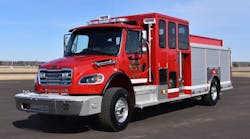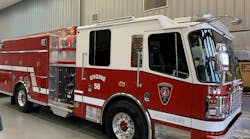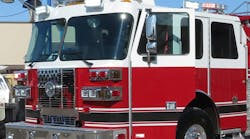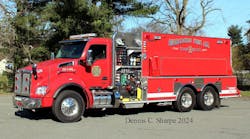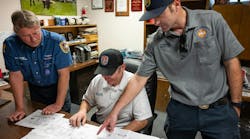Ninety-two firefighters died in the line of duty in 1996 25 career, 64 volunteer and three forestry firefighters. The breakdown of the 1996 fatalities is as follows:
Operating at fires 32
Responding/returning 30
Emergencies 7
Non-emergencies15
Training 8
TOTAL 92
As you can see, fireground deaths led all causes. However, as you can also see, there was a dramatic increase in responding and returning fatalities. If this alarming trend continues in 1997, more firefighters will die while responding and returning from alarms than while doing the job of firefighting itself.
What is tragic is that 90% of the fatal accidents could have and should have been prevented. To this end, we have come up with the top 10 list of ways to avoid being a 1997 NFPA responding and returning statistic:
10. Remember you are no longer in your 2,000-pound personal vehicle. You are now driving a 40,000-pound plus lethal weapon.
9. It is easy to go 55 mph in a fire truck. You're on a launch pad, pointing out, ready to blast off from the apparatus bay. Your vehicle has emergency lights and a siren, people are supposed to get out of your way. However, if you've ever had to make an emergency stop in a fire truck (which few drivers have ever had to do), you would know that it takes over 450 feet to stop the apparatus on dry level pavement. If every firefighter knew how hard it is to stop that much weight going that fast, just maybe we would not go that fast anymore.
8. Defensive driving. Drive it like your whole family is seated next to you. You, as the apparatus operator, are the key to the whole operation. Fire suppression cannot start until you get the personnel and equipment there safely. Approach the driving task with these thoughts in mind.
7. Don't let that natural rush of adrenaline drive the emergency vehicle. Think before you do something that you will regret the rest of your life. A common-sense approach and a good deal of self-restraint will help the apparatus and its crew arrive swiftly and safely to the fire scene.
6. Training. Why is it that fire departments use their fire apparatus the most and train with it the least? Then we turn around and we train the most with the equipment we use the least. Due to government regulation, all firefighters must receive mandated hazardous materials training. How many firefighters have died in hazmat incidents? With this in mind, emergency response driver training should be the number-one priority in every firehouse in this country, bar none.
5. Take the return trip back to the fire station just as seriously as the trip that you made to the fire. Many firefighter fatalities occur while the apparatus is returning from duty. With the exception of the adrenaline and the potential use of the siren and the lights and fatigue, everything remains the same on the return trip. You are responsible for everything and everyone in and around the apparatus, including yourself. You are No. 1.
4. Do not drink or use drugs and drive. At least one firefighter died in 1996 with alcohol in his system at the time of his apparatus accident. Another firefighter has been charged with DWI regarding a minor apparatus accident involving a parked car in March of this year. Unfortunately, alcohol abuse in the fire service is still a major problem.
3. Reduce your speed. Your personal safety is number one and it is your responsibility. Also, you did not start the fire, you are only going to help and you will be no help if you are involved in an accident. Be part of the solution, not part of the problem. If you have the mindset that an emergency vehicle accident will not happen to you, you will have something in common with the 50,000-plus emergency vehicle operators that did have accidents last year. They didn't think it would happen to them either.
2. Wear seatbelts. Between 1984 and 1993, internal trauma injuries (73.6%) and crushing injuries (22.8%) claimed a majority of firefighters in vehicle accidents. If firefighters would ride in enclosed, seated, belted positions on the apparatus, numerous firefighters would still be alive today.
1. Attend the 1997 Firehouse Emergency Services Expo in Baltimore. Come to the emergency vehicle operators seminar; talk to fellow firefighters; look at the new apparatus displays; and attend one of the other seminars. You may pick up that one shred of knowledge that could save your life or someone else's.
If the first half of 1997 is any indication, we need to address the problem of response safety now. I have been sent any number of pictures and accident accounts; I hope the second half of 1997 will be safer. If you have any ideas on how to improve response safety send them to me at Firehouse® Magazine. I will print the best ideas in a future column.
Michael Wilbur will present "Emergency Vehicle Operations" at Firehouse Emergency Services Expo '97 in Baltimore July 24-27.
Michael Wilbur, a Firehouse® contributing editor, is an FDNY lieutenant in Ladder Company 27 in the Bronx and a firefighter in the Howells, NY, Fire Department. He is an adjunct instructor at the New York State Academy of Fire Science and the Orange County Fire Training Center. Wilbur has developed and presented emergency vehicle operator courses throughout the country and has consulted on a variety of fire apparatus issues.
